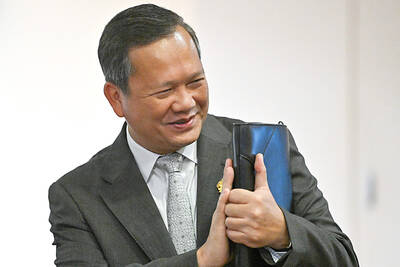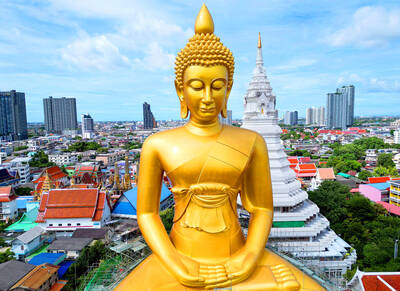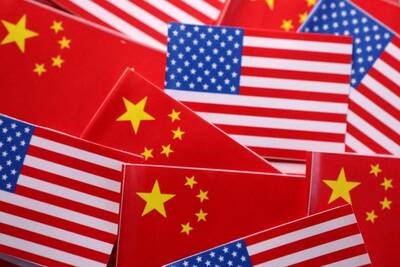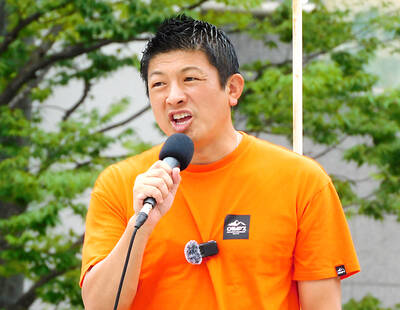Big on spit and polish and parades but short on experience, new technology and force coordination, China’s military has far to go before its bite begins to approach its increasingly loud, and for some fearsome, bark.
China has invested billions of dollars in its armed forces and is developing advanced fighters and missiles, considering building its first aircraft carrier and is trying to slim its bloated ranks down to a lean, high-tech military. The new defense budget unveiled last week was 7.5 percent higher than last year, a modest rise by China’s recent standards, but impressive compared to other big powers.
Those rises have raised alarm in Taiwan, the rest of the region, and especially in the US.
In a report to Congress published last month, the Pentagon said it was concerned by China’s missile buildup and increasingly advanced capabilities in the Pacific region.
Yet while the People’s Liberation Army (PLA) looks increasingly fierce on paper, analysts — and even Chinese army officers — say it will be a long time before the country has the means to effectively challenge US power, if ever.
“What is their readiness level? How effective are these things they’ve developed themselves?” said Drew Thompson, of the Nixon Center, a think tank in Washington.
“Is their indigenous technology really working, or does it simply exist like a lot of things in the Chinese system, on paper? I would posit it probably leans more towards the latter,” he said.
After a spike in tension that has stoked nationalist Chinese calls for a hard shove back against US influence, some PLA officers are also trying to discourage chest-thumping.
“There’s no way China can threaten the United States,” Lieutenant General Li Dianren (李殿仁), a professor at the National Defense University, said on the sidelines of the National People’s Congress.
“Anyone with even a bit of common sense knows that our capabilities do not come even close to matching those of the US. In terms of economics, technology and the military, the gap is huge. How can we threaten them?” he said.
To be sure, China’s military is becoming increasingly assertive, as seen by occasional tiffs at sea and in the air, notably in 2001 when a US spy plane made an emergency landing on Hainan after a collision with a Chinese fighter jet.
Last March, the Pentagon said five Chinese ships harassed a US Navy ship, the Impeccable, an unarmed ocean surveillance vessel, in international waters off Hainan. China says the US ship was carrying out an illegal survey.
PLA showmanship is also grand. A military parade last Oct. 1 marking 60 years since the founding of the People’s Republic of China featured an array of new weapons, all domestically developed.
“China and the United States are rivals. That’s a fact,” said Liu Mingfu (劉明福), author of a book calling for China to develop a military so powerful Washington will not dare challenge it.
“In the past, US presidents didn’t call China a rival, and Chinese presidents never have. But that’s strategic hypocrisy, because each side knows the other is a rival,” he said.
Many practical hurdles could hamper Liu’s goal. China not renowned for producing high quality goods, as a series of product safety scandals in recent years has shown.
“If you go to the PLA and they show you some fantastic new missile on display at an air show, yes they have a missile system, but does it work? Does it work repeatedly and does it work in combat conditions?” Thompson said. “Until you know that for sure you simply assume they’ve got one heck of an interesting platform that might do us some harm ... but the reality might be far different.”
One problem is the US and EU arms embargo against China following the 1989 Tiananmen Square Massacre, and there is little sign they will lift it any time soon.
There’s also inexperience. Unlike the US, China has not engaged in full battle for three decades. Its last major confrontation was with Vietnam in 1979, and that was hardly a glorious victory. Chinese forces crossed the border to punish Hanoi for invading its ally Cambodia, but Vietnam’s battle-hardened troops gave the Chinese a bloody nose.
China has made some impressive technological advances. The successful missile “kill” of an old satellite in 2007 represented a new level of ability. In January, it successfully tested emerging technology aimed at destroying missiles in mid-air.
Integrating such advances into the country’s vast armed forces could be problematic though.
“The [Sichuan] earthquake in 2008 showed their weakness in joint operations,” said Chong-Pin Lin (林中斌), a professor at Tamkang University’s Graduate Institute of International Affairs and Strategic Studies and former vice defense minister.
After the quake, Chinese soldiers involved in rescue efforts struggled with shortages and bottlenecks magnified by poor coordination between forces and units.
However, China’s military edge over technology powerhouse Taiwan is growing.
Even then, not everyone is convinced China could easily overpower Taiwan, despite its advancing weaponry.
“The point is to make the US military stay at a distance,” said Hsu Yung-ming (徐永明), a political science professor at Soochow University, referring to China’s military modernization.

The military is to begin conscripting civilians next year, Cambodian Prime Minister Hun Manet said yesterday, citing rising tensions with Thailand as the reason for activating a long-dormant mandatory enlistment law. The Cambodian parliament in 2006 approved a law that would require all Cambodians aged 18 to 30 to serve in the military for 18 months, although it has never been enforced. Relations with Thailand have been tense since May, when a long-standing territorial dispute boiled over into cross-border clashes, killing one Cambodian soldier. “This episode of confrontation is a lesson for us and is an opportunity for us to review, assess and

IDENTITY: A sex extortion scandal involving Thai monks has deeply shaken public trust in the clergy, with 11 monks implicated in financial misconduct Reverence for the saffron-robed Buddhist monkhood is deeply woven into Thai society, but a sex extortion scandal has besmirched the clergy and left the devout questioning their faith. Thai police this week arrested a woman accused of bedding at least 11 monks in breach of their vows of celibacy, before blackmailing them with thousands of secretly taken photos of their trysts. The monks are said to have paid nearly US$12 million, funneled out of their monasteries, funded by donations from laypeople hoping to increase their merit and prospects for reincarnation. The scandal provoked outrage over hypocrisy in the monkhood, concern that their status

The United States Federal Communications Commission said on Wednesday it plans to adopt rules to bar companies from connecting undersea submarine communication cables to the US that include Chinese technology or equipment. “We have seen submarine cable infrastructure threatened in recent years by foreign adversaries, like China,” FCC Chair Brendan Carr said in a statement. “We are therefore taking action here to guard our submarine cables against foreign adversary ownership, and access as well as cyber and physical threats.” The United States has for years expressed concerns about China’s role in handling network traffic and the potential for espionage. The U.S. has

A disillusioned Japanese electorate feeling the economic pinch goes to the polls today, as a right-wing party promoting a “Japanese first” agenda gains popularity, with fears over foreigners becoming a major election issue. Birthed on YouTube during the COVID-19 pandemic, spreading conspiracy theories about vaccinations and a cabal of global elites, the Sanseito Party has widened its appeal ahead of today’s upper house vote — railing against immigration and dragging rhetoric that was once confined to Japan’s political fringes into the mainstream. Polls show the party might only secure 10 to 15 of the 125 seats up for grabs, but it is